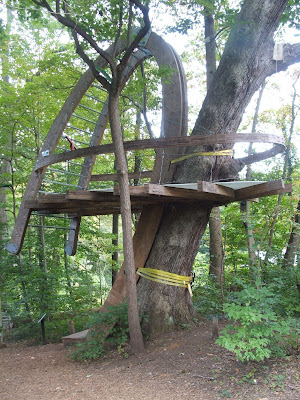Some art is meant to be precious and put on a pedestal, but Chestertown artists Marilee Schumann and Faith Wilson like their art to be part of life. Sit on it, walk on it, make it from wood retrieved from an old shed or leaves lying on the forest path—the two artists see art as an important part of life and act accordingly.
On view at Adkins Arboretum through November 27, their joint show, entitled Palimpsest, includes Schumann’s chairs made from salvaged wood and Wilson’s floor cloths patterned with images stenciled from leaves gathered in the Arboretum’s forest. Although they hang on the wall in this show, these paintings are sturdy enough to place on the floor and use as rugs.
In this elegant show of artworks sharing an autumn palette of red-browns and weathered grays, the art is user-friendly and full of allusions to nature, time and the cycles of life. The public is invited to a reception Sat., Oct. 17 from 5 to 7 p.m., as well as an informal gathering with the artists on Sun., Oct. 18 at 3 p.m.
Both artists, who are sisters, have been fixtures in the Chestertown art scene for many years. Schumann teaches ceramics at Washington College. The two directed Radcliffe Mill Gallery and the Museum of Liminal Art in Chestertown, and both exhibit their work frequently.
Explaining the show’s title, Schumann said, “A palimpsest is a document whose texts have been erased and written over. This wood has had earlier uses, which still show in the traces of tools and hardware, of weather and time, in color and surface, where people and plants and insects have made their marks.”
Schumann, who refuses to cut live wood to make her sculptures, salvaged fallen branches and boards from buildings that had been torn down. All of her sculptures in this show double as functional chairs, complete with rusted hardware and holes drilled by carpenter bees. The back of “Twisted Chair” angles up with the curve of a branch still covered with bark, while “Gee’s Chair,” with one board painted bright blue, was inspired by the acclaimed Gee’s Bend Quilt Collective.
Schumann said, “My chairs are made from a patchwork of reassembled discarded materials, where the marks of time and use, and the wearing of nature and decay tell a story while the material continues to serve.”
Wilson gets irritated when people, thinking that art is always too precious to be touched, refuse to walk on her floor cloths. She paints them with many layers of acrylic, waterborne latex, and polyurethane medium to ensure that they are durable.
“These pieces are meant to be underfoot,” she emphasized. “It’s not just because I want to make utilitarian objects, but to point out that instead of always looking ahead, away from ourselves, how often do we take a moment to look down at where we’re standing? Where we are now. Be in the moment, and be a part of it.”
In her floor cloth titled “Oak Leaves,” rectangles of color appear like windows or veils amid a scattering of oak leaves. Some are solid and colorful, like newly fallen leaves, but others are pale, barely noticeable silhouettes, recalling the frail, ghostlike remains of decaying leaves from past seasons.
Wilson said, “You see the layers of leaves, like time that has passed. They’ve left imprints of themselves on each other. In the stillness, we don’t just hear the sounds of the forest, we hear our own breathing and the beating of our hearts.”
This show is part of Adkins Arboretum’s ongoing exhibition series of work on natural themes by regional artists, funded in part by Caroline County Council of Arts. It is on view through November 27 at the Arboretum Visitor’s Center located at 12610 Eveland Road near Tuckahoe State Park in Ridgely. Contact the Arboretum at 410-634-2847, ext. 0 or info@adkinsarboretum.org for gallery hours.

"Gingko," a floor cloth by Chestertown artist Faith Wilson, is part of Palimpsest, an exhibit showcasing works by Wilson and her sister, Marilee Schumann, on view through Nov. 27 at Adkins Arboretum.
"Chair," sculpted from recycled wood by Chestertown artist Marilee Schumann, is part of Palimpsest, an exhibit showcasing works by Schumann and her sister, Faith Wilson, on view through Nov. 27 at Adkins Arboretum.









